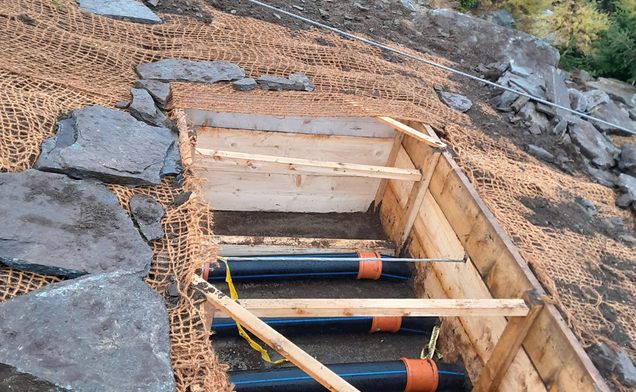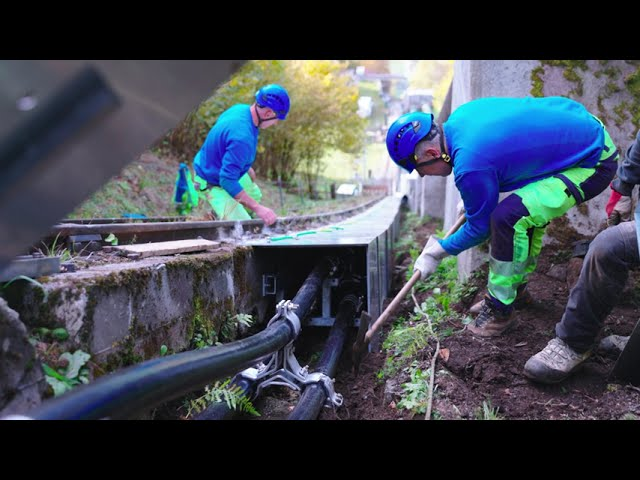Pipeline construction in alpine terrain
November 14, 2023 | Lucia Reinsprecht
Verbund has been building the “Reißeck II plus” power station on the Reißeck lake plateau at 2,300 metres since June 2021, with the access tunnel starting next to a former hotel. The cavern power station inside the mountain complements the Reißeck II power station, which went into operation in 2016, and utilises the difference in altitude between the two Mühldorf lakes. Two pump turbines with a total output of 45 megawatts can store renewable energy when there is a surplus of power and convert it back into electricity when there is a shortage.
Five kilometre-long construction site
A high-voltage line around five kilometres long will supply the power produced by the pumped storage power station to the grid. It begins in the cavern in the high mountains and leads down into the valley to Kolbnitz at 700 metres above sea level. In the first section from the cavern to the mountain station at Schoberboden, the power lines run in the tunnel or in steel pipes.
Empty conduits are then laid in an underground trench in very steep terrain along the old inclined lift from 2,200 metres to 1,500 metres above sea level. This section is tough and requires a lot of expertise and experience. “We have a gradient of up to 45 per cent there,” explains Ferdinand Wirnsberger, Branch Manager, and continues: “Even for our very experienced staff, it is a challenge to move around here safely every day. Here, every move is twice as strenuous and the weather can change in a matter of minutes.”
Iron shields against falling rocks
Occupational safety is a top priority - to protect the team from falling rocks, for example, iron shields are erected and anchored by helicopter at regular spacings. “The production of the cable collar is very complex here and requires special skilled labour,” says Wirnsberger, referring to special devices: “The hard rock is removed using rock cutters and hydraulic chisels with four walking excavators deployed simultaneously and secured with rope winches.”
Strain relief for cables
But laying the pipes alone is not enough. The tension-resistant cable conduits with an outer diameter of 16 centimetres are interrupted every 140 metres and the cables are fixed to concrete foundations. “This is necessary due to the enormous gradient of the terrain, as the weight would cause the cable to stretch,” explains Wirnsberger. Each of the 14 foundations measures 2.5 x 1.5 metres and is anchored in the ground with nine soil nails. Helicopters fly work materials, reinforcement and concrete upwards.
In the middle section, the former railway line of the Reißeckbahn is used. Here, cable brackets are installed over a total length of around 1,400 metres and the cable is protected by a metal cover. Several road culverts will be enlarged and pipe bridges built. In the valley section, most of the pipes will be laid under local roads up to the junction in Kreuzeck. The crossing of the Mölltalbundesstraße will be realised by means of trenchless flush drilling.
Everything to protect nature
In steep terrain, the pipe bedding is made with processed material. Data cables are also being laid in the area of the road and the bedding is on sand. It’s all about protecting nature. “This is a top priority on the entire construction site. The existing humus or turf sod is removed, transplanted to the side and covered again. A coir fabric is laid on all steep and sensitive surfaces. The seed is sown using our own special seed, which is adapted to the respective altitude,” reports Wirnsberger on ecological measures.
In the rocky high mountains, the accompanying ecological measures are even more complex: “Here, the existing turf sods, humus patches and tufts of grass are removed by hand, stored to the side and transplanted back to their original location after the excavation work.” This is all done in close coordination with the ecological building inspectorate.
There are currently 20 employees working on the construction site, and work is due to start again in March 2024 after the winter break. Completion of the major construction site is planned for summer 2024.





![© Felbermayr Slide [Translate to Englisch:]](/fileadmin/_processed_/4/9/csm_DJI_0011_bea_1920_web_4ea5f903bb.jpg)
